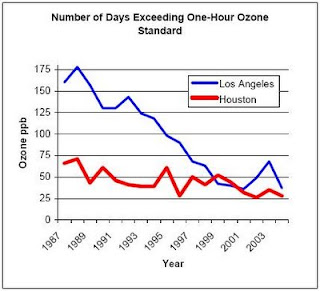I think it would be interesting to poll Americans to see how many have heard of or experienced a "Smog Day". I'm guessing the demographics would be limited. I've asked a few younger friends and my kids and they gave me blank stares.
I grew up in Los Angeles County a few miles from the beach where I attended grade school in the 1970s. I remember several days each year that were "Smog Days". We weren't allowed to play outside and instead had recess and lunch in our classes and were told to put our heads on our desks. On these days, too much activity would make your eyes and lungs burn.
Fast forward 20 years.
My children attended grade school in East Los Angeles County (where the air quality is typically worse than the coast) in the 1990's until we moved to San Diego County in 2000. They never had a "smog day" that I know of.
What changed?
In 1979, the South Coast Air Basin (of which Los Angeles is a part) experienced 228 days above the state one-hour ozone standard; in 2007, the number of days in violation was down to 96. The change is even more dramatic when looking at individual communities. From 1979 to 2007, Pasadena dropped from 191 days over the limit to 13, Reseda from 138 to 22, Anaheim from 61 to 2, Pomona from 167 to 19, and West Los Angeles from 76 to 2. This story is replicated across the region. It is also broadly true for the other pollutants that comprise smog.[1]
Here's an interesting chart. It doesn't go back to the 1970s, but you can see the trend. (I'm glad I don't live in Houston ;-)

Why did it change?
A series of "Clean Air Acts"[2] in 1963, 1967, 1970, 1977 and 1990 were enacted by the Federal Government to limit air pollution (The EPA was created in 1971). The result is a much better quality of life for millions of people.
How did it change?
Technological solutions: catalytic converters, unleaded gasoline, smog checks, etc.
Note: The Government didn't spend money to fix the problem. They set standards and intelligent, inventive people found solutions.

1 comment:
Interesting!
Post a Comment